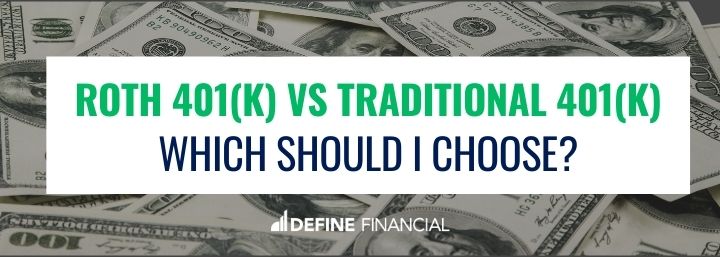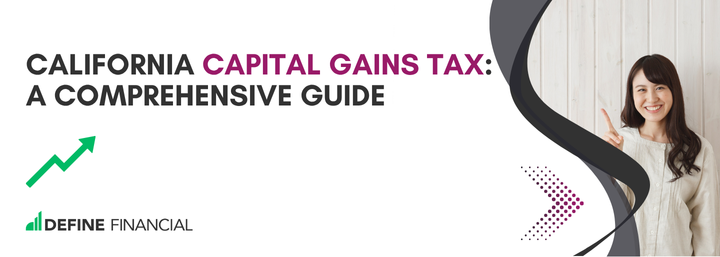
If you got a tax refund of $4,500, would you spend it or invest it?
If you’re like most people, you’d be thrilled to see that cash land in your account. It could pay for an awesome vacation or wipe out some credit card debt.
But if you’re also investing in a 401(k), that $4,500 could be the difference between retiring and struggling.
In today’s post, we address a question from one of our clients, who says, “I just looked at my 401(k) account and I have the option to do a Roth 401(k). What are your thoughts between Traditional and Roth?”
Let’s dig in.
Tax Arbitrage
The client is in her late 20s. Given her young age, the rule of thumb on “Roth vs. Traditional” provides a simple answer: pick the Roth. The reason is that when you’re in your 20s, you’re in a lower tax bracket now than you will be in the future.
Tax Bracket Today < Tax Bracket in the Future
Young folks are just starting to tap into their earning potential. Their salary reflects this. While their starting salary is relatively low, it will increase with time. And with that higher salary comes a higher tax bracket (and higher taxes).
Therefore, a young person doesn’t get a lot of tax savings (relatively) by choosing the Traditional 401(k) option. By picking the Roth option, a young person pays a little bit of taxes now (on salary income) to save a lot on taxes (on investment income) in the future.
Roth option at a young age:
Money Paid in Taxes Today > Money Saved on Taxes in the Future
It might make sense to switch to a Traditional 401(k) in the future – when you’re in a higher tax bracket. At that time, you’re paying more income taxes.
Traditional option with high salary:
Money Saved in Taxes Today > Money Paid on Taxes in the Future
In short, young individuals (who are making relatively less income today compared to their future earnings) should opt for the Roth option.
Now that we’ve covered the basic answer on the Traditional vs Roth question, let’s dive a little deeper.
You’ll Save More Money With a Roth
The Roth 401(k) does one thing that the Traditional 401(k) rarely does: it encourages long-term saving. This reasoning is less popular than the tax arbitrage argument. (And I’m actually stealing this idea from Clark Howard.) But this is the reason I like the Roth option over Traditional.
When you put $18,000 into a traditional 401(k), you get a tax break. And that’s all well and great. But what are you going to do with that tax break?
Usually, getting a tax break does not mean more money saved. Let’s say you have $18,000 to put into your Traditional 401(k). The following year, you get $4,500 back in the form of a tax refund.
Would you put that $4,500 into an investment account for retirement? That $4,500 usually goes anywhere but additional retirement savings.
What’s the consequence of not investing that $4,500 tax break? You have less retirement savings than you would have with a $18,000 contribution to a Roth 401(k).
When you make an $18,000 contribution to your Traditional 401(k), you’re not actually saving $18,000. You’re really saving $13,500 (assuming a 25% future tax bracket).
This is because the taxes you get hit with when you take money out of a Traditional 401(k) are higher.
Traditional 401(k) contribution – tax refund today = less money in the future
How do you avoid getting hit with taxes when you take money out of your retirement account (and therefore effectively save more money)?
Use the Roth 401(k).
With a Roth account, when you put in $18,000, you’re saving $18,000. In retirement, you get to take out $18,000 (and its growth) without any taxes.
When you use a Roth account, you’re effectively increasing your retirement savings by your tax bracket (compared to a Traditional 401(k) account). Between state and Federal taxes, this means you can have more than twice as much money.
Of course, some folks will argue that there are better tax and investment strategies when you save $18,000 in a Traditional 401(k) and invest the tax refund. But most people don’t invest their tax refund. They spend it instead.
In short, using a Roth account means you’re saving more money. And when you save more money, you HAVE MORE MONEY!
No RMDs When You Rollover to a Roth IRA
Here’s the final reason why I like Roth 401(k)s more than Traditional 401(k)s. You can avoid Required Minimum Distributions (RMDs).
Retirement accounts (like IRAs and 401(k) plans) are a great place to invest because they receive special tax treatment. This means more money for you because your investments grow without taxes slowing them down.
Unfortunately, you don’t usually get to take advantage of that tax treatment forever.
RMDs require that you take a certain amount of money out of the tax-advantaged account every year. When that happens, the money taken out of the account loses its special tax treatment.
Once outside the account, that money cannot grow as quickly because it’s no longer receiving special tax treatment.
Growth with Good Tax Treatment > Growth without Good Tax Treatment
This rule applies to 401(k)s. You must make RMDs each year. This means that eventually, the money you have invested will lose its special tax treatment.
RMDs for a Traditional 401(k) are unavoidable. That’s not the case with a Roth 401(k).
You can avoid RMDs on your Roth 401(k) by rolling your Roth 401(k) into a Roth IRA. This is not an option for a Traditional 401(k). If you roll your Traditional 401(k) into a Traditional IRA, you must still make RMDs.
Now, the question of rolling your 401(k) into an IRA has all sorts of considerations – such as investment options, fees, and creditor protection.
So, discuss with your advisor if a rollover is right for you. For now, we’re going to stay focused on the advantage of doing the Roth 401(k) to Roth IRA rollover: no RMDs with a Roth IRA.
The Advantage of Not Having RMDs
I already talked about the value of keeping your money in an investment account getting special tax treatment…your money grows quicker (and therefore, you get more of it). But, another reason is human behavior.
As a human being, you may be tempted to spend the entirety of your RMD money. After all, if you have to take money out of an account, why not spend it?
And if you have more money saved in non-RMDs accounts, that may be OK.
But most people are dealing with a shortage of savings, not a surplus. And with the 401(k) as the foundation of their retirement, it may not make sense to spend money just because tax law requires you to move it out of an account.
People who saved too much < People who saved too little
Because of human behavior, I like accounts without an RMD. With a Roth IRA, not spending money is the default option. Money only comes out of the Roth IRA when a conscious decision is made to spend money. With a Roth IRA, the default option is to save money.
With a traditional 401(k), money falls into the account owner’s lap every year – regardless of the client’s actual need.
Pick the Roth
I strongly suggest the Roth option. I suggest Roth accounts for all clients, of all ages, in all tax brackets, every time.
Of course, there are always exceptions. There are folks who will invest their tax refund or re-invest their RMDs. But, you’d be the rare case.

